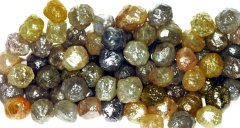| The Very Highest Quality Diamond Information... |
| Chameleon Diamonds |
|
|

|
|
|

|
|
|
Natural, Enhanced, or Synthetic
Nowadays, we always have to consider whether any fancy coloured diamonds are naturally occurring mined diamonds, naturla mined diamonds which have undergone some form of colour enhancement, or even synthetic stones with or without any other treatment. Most of the comments we make will be assumed to apply to natural diamonds, but anything which applies to natural diamonds should also be assumed to be possible for synthetic and treated stones also, as some of the treatments are likely to replicate those which may have occurred to completely natural stones millions of years ago.
Our First Experience
Way back in 1995, we bought four coloured diamonds, totalling 1.94 carats in weight, all four stones being around a half carat each, ranging from 0.42 to 0.53 carats. Each one was a different colour, and each one looked a different colour in different lights, so much so that we often had difficulty remembering which was which, and we had to get all four together to remind ourselves. The colours were, subject to some dimming of memory coupled with the difficulty of translating colours into words, yellow-green, yellow-orange, yellow-brown, and orange.
While trying to recall their descriptions, I came across an entry in our stock database which tells me that each one had an IGI certificate stating it to be a natural fancy coloured diamond, a fact I had forgotten. I wish we still had these stones in stock, as they would have made interesting demonstration stones. We think the differing colours would have classed three if not all four of these diamonds as chameleons.
Yellow Olive Green Gray
Most diamonds classed as chameleon stones are green or greenish gray when viewed normally, but acquire a strong yellow colour, usually with some olive green, if heated to about 250° C. Although this would not be a normal viewing temperature for any diamond, it is still only a moderate temperature compared with those attained in jewellery manufacture and repair work which can commonly be in the 700 to 1,000 range. It is considerably more than a diamond would be stored or viewed at normally, and would only be experienced in a workshop or laboratory by a gemmologist.
It is our opinion, partly from our first expeprience, that there must also be a number fo diamonds which display chameleon effects at more normal temperature ranges, simply by viewing in different light sources. Light sources are often classed by colour temperature, but this can only be an approximate guide to the specral range of wavelengths present in varying amounts.
Cause of Chameleon Effect
Some research has been done, and it appears that the chameleon effect can occur in diamonds of all four types, as can green diamonds, and that the cause of the chameleon effect appears to be mainly due to the presence of hydrogen in the diamond lattice structure, and that this hydrogen can be sensitive to infra-red wavelength light, causing either emissions of yellow light or absorption in complementary wavelengths. Some nickel is also present in some chameleon diamonds, and this appears to modify or intensify the effects of the hydrogen. These conclusions are from our interpretations of spectrometry analyses on the Gemlab site and elsewhere.
Fluorescence & Phosporescence
Flruoescence is the absorption of light of various wavelengths, including ultra-violet and infra-red, and its immediate re-transmission as other wavelengths.
Phosporescence is essentially the same process after a delay, because the phosporescent material aborbs the incoming radiation, stores it as potential energy, then re-transmits it some time later. Phosporescence can last from a fraction of a second to several minutes, hours or longer.
Phonons
While researching for this page, we came across a new (to us) word. A quick Google search found many entries including this from Wikipedia, which we may as well quote verbatim:
Phononso now you know!
From Wikipedia, the free encyclopedia.
A phonon is a quantized mode of vibration occurring in a rigid crystal lattice, such as the atomic lattice of a solid. The study of phonons is an important part of solid state physics, because phonons play an important role in many of the physical properties of solids, such as the thermal conductivity and the electrical conductivity. In particular, the properties of long-wavelength phonons gives rise to sound in solids -- hence the name phonon. In insulating solids, phonons are also the primary mechanism by which heat conduction takes place.
Phonons are a quantum mechanical version of a special type of vibrational motion, known as normal modes in classical mechanics, in which each part of a lattice oscillates with the same frequency. These normal modes are important because, according to a well-known result in classical mechanics, any arbitrary vibrational motion of a lattice can be considered as a superposition of normal modes with various frequencies; in this sense, the normal modes are the elementary vibrations of the lattice. Although normal modes are wave-like phenomena in classical mechanics, they acquire certain particle-like properties when the lattice is analysed using quantum mechanics (see wave-particle duality.) They are then known as phonons. Phonons are bosons possessing zero spin.
Diamond 4C's Tour - Next Stop - Clarity
| ...at the Lowest Possible Price |
|
32 - 36 Harrowside, Blackpool, Lancashire, FY4 1RJ, England. Telephone (44) - (0) 1253 - 343081 ; Fax 408058; E-mail: The URL for our main page is: https://24carat.co.uk | Chard(1964) Ltd |